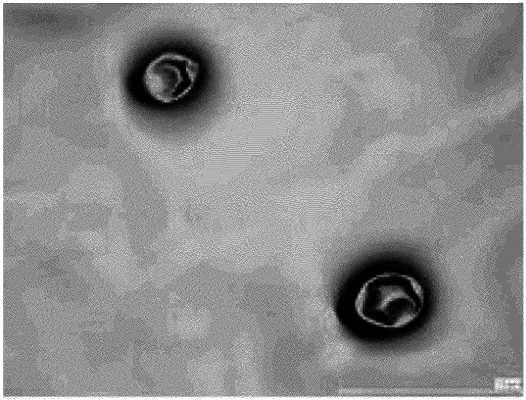| CPC B22D 11/0611 (2013.01) [B22D 11/0622 (2013.01); B22D 11/0651 (2013.01); B22D 11/0682 (2013.01); C21D 9/0068 (2013.01); C22C 45/008 (2013.01)] | 2 Claims |

|
1. A method for producing an Fe-based nanocrystalline alloy ribbon, the method comprising:
supplying a molten Fe-based alloy onto a rotating chill roll, and rapidly solidifying the molten Fe-based alloy that has been supplied onto the chill roll, thereby obtaining an Fe-based amorphous alloy ribbon having a free solidified surface and a roll contact surface, and having a width of from 5 mm to 65 mm and a thickness of from 10 μm to 15 μm; and
heat-treating the Fe-based amorphous alloy ribbon, thereby obtaining an Fe-based nanocrystalline alloy ribbon,
wherein an outer peripheral part of the chill roll is composed of a Cu alloy, and a thermal conductivity of the outer peripheral part is in a range of from 110 W/(m·K) to 225 W/(m·K), and a Vickers hardness of the outer peripheral part is in a range of from 250 HV to 400 HV,
a number of protrusions P in the free solidified surface of the Fe-based nanocrystalline alloy ribbon, each having a depression at a central part thereof, is 1.2 or less per 100 mm2 of area,
warpage of the Fe-based amorphous alloy ribbon in the width direction is 0.30 mm or less per 10 mm of width, and
the Cu alloy is a Cu—Be alloy containing Be in an amount of from 1.6% by mass to 2.2% by mass with respect to the entire Cu—Be alloy, wherein the molten Fe-based alloy has an alloy composition represented by the following Composition Formula (A):
Fe100-a-b-c-d-eCuaSibBcNbdCe Composition Formula (A):
wherein, in Composition Formula (A), each of 100-a-b-c-d-e, a, b, c, d, and e represents an atomic percent of a relevant element when a total of Fe, Cu, Si, B, Nb, and C is 100 atom %, and a, b, c, d, and e satisfy 0.30≤a≤2.00, 13.00≤b≤16.00, 6.00≤c≤11.00, 2.00≤d≤4.00, and 0.04≤e≤0.40, respectively.
|
|
2. A method for producing a magnetic core comprising a wound body C in which an Fe-based nanocrystalline alloy ribbon is wound via an insulation layer, the method comprising:
supplying a molten Fe-based alloy onto a rotating chill roll, and rapidly solidifying the molten Fe-based alloy that has been supplied onto the chill roll, thereby obtaining an Fe-based amorphous alloy ribbon having a free solidified surface and a roll contact surface, and having a width of from 5 mm to 65 mm and a thickness of from 10 μm to 15 μm;
forming the insulation layer on the free solidified surface of the Fe-based amorphous alloy ribbon:
winding the Fe-based amorphous alloy ribbon having the insulation layer formed thereon, thereby obtaining a wound body A in which the Fe-based amorphous alloy ribbon is wound via the insulation layer; and
heat-treating the wound body A, thereby obtaining the wound body C,
wherein an outer peripheral part of the chill roll is composed of a Cu alloy, a thermal conductivity of the outer peripheral part is in a range of from 110 W/(m·K) to 225 W/(m·K), and a Vickers hardness of the outer peripheral part is in a range of from 250 HV to 400 HV,
a number of protrusions P in the free solidified surface of the Fe-based nanocrystalline alloy ribbon, each having a depression at a central part thereof, is 1.2 or less per 100 mm2 of area,
warpage of the Fe-based amorphous alloy ribbon in the width direction is 0.30 mm or less per 10 mm of width, and
the Cu alloy is a Cu—Be alloy containing Be in an amount of from 1.6% by mass to 2.2% by mass with respect to the entire Cu—Be alloy, wherein the molten Fe-based alloy has an alloy composition represented by the following Composition Formula (A):
Fe100-a-b-c-d-eCuaSibBcNbdCe Composition Formula (A):
wherein, in Composition Formula (A), each of 100-a-b-c-d-e, a, b, c, d, and e represents an atomic percent of a relevant element when a total of Fe, Cu, Si, B, Nb, and C is 100 atom %, and a, b, c, d, and e satisfy 0.30≤a≤2.00, 13.00≤b≤16.00, 6.00≤c≤11.00, 2.00≤d≤4.00, and 0.04≤e≤0.40, respectively.
|